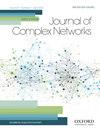捆绑衰减网络上传染病的流行阈值
IF 1.5
4区 数学
Q2 MATHEMATICS, INTERDISCIPLINARY APPLICATIONS
引用次数: 5
摘要
在对网络传染病的研究中,研究人员计算流行病阈值,以帮助预测一种疾病最终是否会感染很大一部分人口。由于网络结构通常随时间而变化,这从根本上影响传播过程的动态,进而影响疾病传播的流行阈值,因此在时间网络上研究疾病传播模型中的流行阈值是很重要的。现有的关于时间网络中流行病阈值的研究大多集中在离散时间模型上,但大多数现实世界的网络系统随着时间的推移而不断发展。在本文的工作中,我们通过研究一种基于关联衰减网络的SIS模型,对易感-感染-易感(SIS)过程的流行阈值评估中网络的连续时间依赖性进行了编码。推导了该模型的流行阈值条件,并进行了数值实验验证。我们还研究了不同的因素——网络中纽带强度的衰减系数、网络中节点之间相互作用的频率以及发生相互作用的潜在社会网络的稀疏度——如何导致临界值的降低或增加,从而有助于促进或阻碍疾病的传播。因此,我们证明了结衰网络的特征如何改变疾病传播的结果。本文章由计算机程序翻译,如有差异,请以英文原文为准。
Epidemic thresholds of infectious diseases on tie-decay networks
In the study of infectious diseases on networks, researchers calculate epidemic thresholds to help forecast whether or not a disease will eventually infect a large fraction of a population. Because network structure typically changes with time, which fundamentally influences the dynamics of spreading processes and in turn affects epidemic thresholds for disease propagation, it is important to examine epidemic thresholds in models of disease spread on temporal networks. Most existing studies of epidemic thresholds in temporal networks have focused on models in discrete time, but most real-world networked systems evolve continuously with time. In our work, we encode the continuous time-dependence of networks in the evaluation of the epidemic threshold of a susceptible–infected–susceptible (SIS) process by studying an SIS model on tie-decay networks. We derive the epidemic-threshold condition of this model, and we perform numerical experiments to verify it. We also examine how different factors—the decay coefficients of the tie strengths in a network, the frequency of the interactions between the nodes in the network, and the sparsity of the underlying social network on which interactions occur—lead to decreases or increases of the critical values of the threshold and hence contribute to facilitating or impeding the spread of a disease. We thereby demonstrate how the features of tie-decay networks alter the outcome of disease spread.
求助全文
通过发布文献求助,成功后即可免费获取论文全文。
去求助
来源期刊

Journal of complex networks
MATHEMATICS, INTERDISCIPLINARY APPLICATIONS-
CiteScore
4.20
自引率
9.50%
发文量
40
期刊介绍:
Journal of Complex Networks publishes original articles and reviews with a significant contribution to the analysis and understanding of complex networks and its applications in diverse fields. Complex networks are loosely defined as networks with nontrivial topology and dynamics, which appear as the skeletons of complex systems in the real-world. The journal covers everything from the basic mathematical, physical and computational principles needed for studying complex networks to their applications leading to predictive models in molecular, biological, ecological, informational, engineering, social, technological and other systems. It includes, but is not limited to, the following topics: - Mathematical and numerical analysis of networks - Network theory and computer sciences - Structural analysis of networks - Dynamics on networks - Physical models on networks - Networks and epidemiology - Social, socio-economic and political networks - Ecological networks - Technological and infrastructural networks - Brain and tissue networks - Biological and molecular networks - Spatial networks - Techno-social networks i.e. online social networks, social networking sites, social media - Other applications of networks - Evolving networks - Multilayer networks - Game theory on networks - Biomedicine related networks - Animal social networks - Climate networks - Cognitive, language and informational network
 求助内容:
求助内容: 应助结果提醒方式:
应助结果提醒方式:


